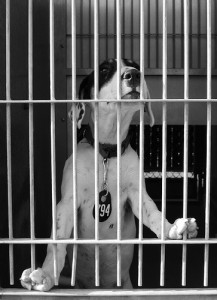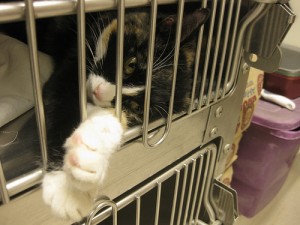Should I Choose a Dog or a Cat as a Pet?
June 13, 2010 by LaBecs
Filed under Should I choose a dog or a cat as a pet?
You want to adopt a pet, but how do you decide if you want a dog or a cat? Well, the obvious answer lies within you: are you a “dog person”, or a “cat person”? Most people already know this, but if you really never thought about it, let’s see what advantages or disadvantages each species has to help you decide.
Cats and dogs have different needs and characteristics. One thing that applies to both is that they all need attention, you need to budget for their veterinary care, food and emergencies, you need to clean after them, and you have to love them unconditionally.
Now, for the differences.
Dogs:
Your lifestyle will definitely determine if you should have a dog or a cat as a pet. If you like to travel a lot, or work all day, a dog is not for you.
-Different breeds have different characteristics, you should choose one that matches your personality and lifestyle.
-If you travel, boarding a dog is quite expensive.
-A dog needs company and attention. If you have a dog and leave him home alone all day, you will have a very unhappy pet.
-Dogs need exercise. More or less depending on the breed.
-You need to walk them at least a couple of times daily for them to do “their thing”.
-Dogs need to be trained, socialized and housebroken.
-Dogs like to play. They need to be stimulated and love to play with their masters.
-Some dogs shed a lot. You have to be prepared to clean after them constantly.
 -Dogs need to be groomed often. You need to brush their coat, bathe them, and brush their teeth.
-Dogs need to be groomed often. You need to brush their coat, bathe them, and brush their teeth.
-A small dog is a little easier to take care of, but it still needs walks, play and attention. A big dog obviously needs more space.
-A small dog eats very little, but a big dog will eat a lot. You have to be ready for the expense of feeding.
-Dogs love to ride in the car and go hiking, swimming and all kinds of outdoor activities.
-A dog will greet you happily every time you come home, he will want to sleep with you, and in general, share everything with you.
-There are many dog parks where you can take your pet to run and play.
-Dogs are protective of their humans and will be faithful forever.
Cats:
If you work outside your home or travel a lot, and the pet needs to be alone for many ours, a cat might be for you.
-If you travel, boarding a cat is not as expensive, depending on the facility. They could be left at home with a pet sitter visiting once or twice a day.
-All cats have different personalities. Some are affectionate lap cats, and others are more energetic and don’t like to be petted as much. Choose carefully.
-A cat can be left alone to sleep most of the day.
-Cats are independent, but that does not mean you can live them alone all day and not pay any attention to them. They do love company.
 -Cats need to play and be stimulated. They entertain themselves more easily without being destructive.
-Cats need to play and be stimulated. They entertain themselves more easily without being destructive.
-Cats are very easily trained to use their litter box, which requires cleaning at least once a day.
-There’s no need to walk them, though some cats like to walk on a leash.
-Some cats are easily trained to do tricks. Some are very good at fetching.
-Cats eat very little depending on their size, but never as much as a dog.
-Cats don’t need to be bathed, but they do need to get brushed and you need to brush their teeth regularly.
-You can get a cat used to car rides, but they mostly prefer to stay at home.
-Cats can live in small apartments. It’s actually better to always keep them indoors.
-Contrary to popular belief, cats will greet you at the door and follow you around like a dog.
-Cats are playful and a delight to watch as they jump and run and chase.
-You need to have space for a litter box in a well ventilated area, away from kids and out of site.
-Cats like to have scratching posts or kitty condos.
-Cats love to cuddle.
-Cats can be very protective of their humans and will be faithful forever. They do get attached to their owners.
I am one of those strange people that is a cat person and a dog person. I love them both with all my heart and enjoy their different personality traits. I have never had two cats with the same personality, it’s always an adventure to get to know them. And dogs for me, are the best company you can ever ask for. But one thing is certain, both species are incredible, and everybody should have the experience of living with one or both of them at some point.
The Differences Between Cats and Dogs
August 10, 2009 by LaBecs
Filed under Differences Between Cats and Dogs
We could spend years debating why are cats and dogs different? But, the answer is easy… they are different species. While it can take weeks to train a cat to “come” or “sit”, dogs can learn this behavior in just about five minutes. On the other hand, cats learn to use a litter box with almost no training, but it can take tons of persistence to do the same with a small dog. It’s obvious that what’s important for dogs is not important for cats and vice versa. 
The main difference is this: dogs are pack animals; cats tend to be more independent, though not solitary animals as some perceive them.
Dogs are social creatures and are happy and content in a group situation.
If an owner provides proper leadership, he or she becomes the pack leader and the dogs will view them with respect. However, if they are treated badly, they will still remain in the pack because they are attached to their people.
Cats form groups, but there is not a structure of leadership. They are very territorial but they will share their territory, as long as their needs are met and they’re not treated badly.
Dogs normally attach to its group, and not their surroundings. You can take your dog to work with you or move to another house, and the dog will be happy as long as he’s with you. Although cats also get attached
to people, if you take your cat away from its regular surroundings, he or she will develop fear and anxiety.
Dogs learn everything from observing other pack members. They learn by interacting with their owners.
When the leader uses rewards to get behaviors that will ‘group the pack’, such as “come” or “sit”, dogs respond promptly. It’s embedded in their DNA. Dogs can be trained because they desire to please their owners.
Cats…. well, it’s not the same with them.
Dogs also learn what not to do when another member of the pack growls or snips at them. The dog will avoid repeating the situation, especially to please a high ranking member of the pack. That negative reinforcement works with dogs, but a cat, will avoid the source of the punishment, clearly, their owner, so punishment will not work on a cat.
 Picture a hunting situation in the wild with a cat: she goes out hunting alone, stalks her pray, and in case of danger, she can jump and climb to get away. Now picture a dog in the same situation. He follows his pray through scent, but he’s not very stealthy. If confronted, he will have to fight. Dogs use fighting to defend themselves; cats are agile enough to escape. The concept of ‘flight or fight’ is very important for dogs. That’s why hunting in a pack is what’s effective for them.
Picture a hunting situation in the wild with a cat: she goes out hunting alone, stalks her pray, and in case of danger, she can jump and climb to get away. Now picture a dog in the same situation. He follows his pray through scent, but he’s not very stealthy. If confronted, he will have to fight. Dogs use fighting to defend themselves; cats are agile enough to escape. The concept of ‘flight or fight’ is very important for dogs. That’s why hunting in a pack is what’s effective for them.
What does all this mean?
The difference between cats and dogs can be summarized beautifully with this statement: “My dog looks at all the things I provide for her and says ‘You must be God.’ My cat looks at all the things I provide for him and says ‘I must be God’”.
The Awful Reality of Puppy Mills
June 1, 2009 by LaBecs
Filed under The Awful Reality of Puppy Mills
You’ve probably heard about puppy mills. But did you know that if you purchase a dog from a pet store and many of the breeders online or in the newspaper, you could be helping keep the puppy mill industry afloat?
Most people don’t realize where those dogs who suffer so much end up. They often don’t even know how much suffering the dogs have to endure. Below is some information you should read before you decide how to find your new canine companion.
The Abuses of Puppy Mills
If you’re not familiar with the term “puppy mill”, you may want to learn about them before you start looking around for your new puppy or dog. Basically, puppy mills operate like factories to produce new offspring that can be sold.
Female dogs are bred from their first heat cycle and again each time until they are no long able to reproduce. Then they are “disposed of.” The puppies are kept with their mothers in tiny cages, usually stacked on top of one another in cramped and dirty environments. Because the cages are made from wire, the excrement and urine from the above dogs can fall down onto the lower dogs. The wire cages also cause foot injuries and are very uncomfortable.

A Living Hell
Most of the dogs are underfed. Most have worms because of their close quarters and their unhygienic environment. Fleas and mites are huge problems because most of these puppy mills are located in the country and none of them receive any type of preventative care. Some even contract heart worms and other serious illnesses. They also tend to have emotional problems because they lack any human contact during their formative years, and because their mothers are usually too weak to give them much compassion.
In some of the worst of these places, dead dogs are left in the cages to decompose with the living ones.
Where the Puppies Go
As you can imagine, most “hell operators”, as I like to call them, do not sell their “stock” from their factory. Instead, they have other ways of connecting with potential customers. Pet shops are one of the largest buyers. Most of the dogs you see being sold in pet stores for hundreds of dollars were bought for a fraction of that from puppy mills. However, since the puppy mills sell hundreds of dogs every couple of months, they are profiting from these sales in major ways.
But pet stores are only one method. Many of the breeders who advertise online and in the newspaper are also puppy mills themselves or are selling supplies of dogs they have gotten from puppy mills.
What you get is a puppy facing an array of immediate medical problems and with genetic diseases that will surface years later.
Signs of a Puppy Mill
Regardless of what pet stores may say, their supply of dogs comes from puppy mills. However, with breeders, you may have a harder time recognizing the possibilities. To protect yourself, always ask to visit the puppies on-site so you can view the condition of the mother and possibly the father. For obvious reasons, if you are buying directly from a puppy mill, they will have some excuse as to why you cannot do this.
If you do arrive on-site but are not allowed to see the mother of the puppies, this is also a sign the puppies may be from a puppy mill and that the mother may be another location altogether.
Never buy a puppy without seeing where they and their parents are raised and housed with your own eyes. Do your research; get references about breeders in your area.
While your heart may go out to these suffering puppies, when you buy them from these sources you’re only contributing to the problem and continuing the puppy mill business. That’s why I always urge and encourage people to adopt either from a humane society, a rescue, or a shelter, and help put those torture chambers out of business for good.
Top 12 Friendliest Dogs
April 24, 2009 by LaBecs
Filed under Friendliest Dogs
When you decide to bring a new dog into your life, it helps to know its temperament, what’s the breed’s normal behavior, what are its characteristics, etc. Some dogs are great for kids, when some others are better suited for athletic grown ups, and yet others are better with elderly people. But, which breeds make the friendliest dogs? Some breeds are friendlier by nature than others, that’s not to say that a dog’s temperament cannot be greatly dependent on the owner’s behavior and lifestyle. It also doesn’t mean that if the breed tends to be friendly, it’s automatically an appropriate breed for all people. To help you do your homework, here’s a list of the top 12 friendliest dogs around.
Click on the pictures to learn more!
 #12 #12Brittany Spaniel |
 #11 #11Japanese Chin |
||||||||
 #10 #10Vizla |
 #9 #9Springer Spaniel |
||||||||
 #8 #8Cavalier King Charles |
 #7 #7Papillon |
||||||||
|
|||||||||
CLICK HERE TO SEE THE FRIENDLIEST CATS…
Photo credits:
How to Choose the Right Dog
March 24, 2009 by LaBecs
Filed under How to Choose the Right Dog
You might think that deciding whether to adopt a dog or not is the toughest part. However, wait till you get to the shelter! With so many little adorable four-legged fur-balls and puppy-eyes around, you just won’t know which one to take home! They come in so many shapes and sizes and each of them has one adorability factor or another and it can just get to be too much. You have to understand that if you don’t know how to choose the right dog there will be problems down the line.
It would be really unfair, incorrect actually, to say that one breed is better than other, especially in a shelter, where any one of the dogs could be a treasure. What is actually of essence is to see which dog would be better for your specific situation, needs and limitations. Therefore, the following points might help:
1. Understand your limitations
Understanding your constraints as an owner is the first step. This is more important than deciding which dog looks cutest. Let’s say you live in condo or an apartment, in which case you would want a dog that is small and can do without much daily exercise. If you have a large house with a backyard, then almost any breed will work fine. Think about your time commitments, the other members of the household, even your social life will decide which personality, breed and size will work for you.
2. Learn about different breeds

Chuck and Terry
The breed of the dog considerably influences his or her personality, behavioral traits and physiology – and you need one that matches your considerations. Essentially there are two basic classifications: pure breeds and mixed breeds. Purebred dogs come from a family of same breeds and thus it is easier to know for sure what traits he will display and what his health might be like. With a mixed breed, the parental lineage could include just about any dog. These breeds tend to be genetically more sound, and often show very good health when cared for well. Also, you get the qualities of various dogs in one. Of course some people prefer pure breeds for the certain snob value they hold, but after all, it’s all about who wins your heart.
3. Visit the shelter
Once you have some idea about the different breeds, a visit to the shelter will prove beneficial. Now, a shelter is not exactly the best place for a dog and most of the time the dog will not be himself. Therefore first impressions could be wrong. It is good to have an adoption counselor by your side as you walk through or a volunteer who might be able to give you a better insight into the dog’s personality and help you make a decision. Insist on spending sometime alone with a few dogs that you might like and consider the following:
Age: A younger puppy is usually desired since it is easier to habituate a pup to your home and lifestyle. However, puppies also require some training – especially toilet training and general obedience training. Older dogs, on the other hand, are already trained by their owners which would be saving you some effort. However, they might also posses certain habits that don’t go down well with you and it’s hard to change that with older dogs. Decide depending on your lifestyle.
Size: Think if you want to be able to take your pet along often, in which case you need a smaller kind. However, if you have young kids, the smaller dogs are not the most appropriate. Again, check your breed characteristics.
Personality: Dogs are usually shy and quiet or assertive and active. If you like some peace and quiet, then a terrier who barks his head off at any new thing may not be for you. But if you like jogging, running around parks or have active kids, then an active retriever will suit you just fine
Social disposition: Depending on their past experiences with people, certain dogs are very picky about social interaction. They will just not let anyone but their owner touch them and could turn quite hostile if someone intrudes on their privacy. Therefore, try to find out a little about the dog’s background to avoid any unpleasant surprises. Most dogs however, tend to be social and very friendly. Take a look at the dog’s history and discuss his general behavior with the counselor or volunteers and you will have an idea how good he is with people.
Usually, if a dog’s previous owners were unkind to him, or even violent, the dog might be untrusting of all people. Although such dogs deserve love and care as well, it’s up to you to decide if you are in a situation to provide it with the patience that it requires.
A dog will be your best friend for life!
A dog suited to your personality and lifestyle can bring you great joy and fun, and a wrong decision might bring you some inconveniences that shadow on the happy parts. Although all dogs can be your best friends, this is going to be more like a live-in relationship; so you need to be very sure of your compatibility. Trust me, breaking up with your dog can be very painful.
Neutering or Spaying Your New Dog
March 24, 2009 by LaBecs
Filed under Neutering or Spaying Your New Dog
If you are having doubts about neutering or spaying your new dog, you have to consider the benefits for his or her health and for both your lives.
Male dogs are not “manly” and female dogs do not “need” to have puppies.
There are people (usually men… no offense, guys) that actually think that keeping their dog’s testicles intact is manly, both for the dog and for the owner… sometimes, people go as far as to have prosthetic testicles inserted for their neutered dogs. To each it’s own, but… really?
Also, breeding a dog is not necessarily better for the animal, neither male nor female, and it certainly can make dogs much more difficult to manage if they are not neutered.
Unless there is a specific reason to breed your dog, it should be neutered or spayed at an early age to prevent pregnancies, avoid aggressive male behavior, and even lessening the possibilities of some forms of cancer.
It’s normally recommended that the dog gets neutered between 2 and 6 months old. Of course, there is always a small risk associated with any sort of surgery, but it’s riskier to own a dog with an aggressive sex drive. Another reason to do it early, is that younger pups manage through the surgery option much better than older dogs. The surgery is very simple and can be performed in a matter of minutes.
Now, let’s clarify some myths:
Early neutering or spaying does not stunt growth. That’s a myth propagated by breeders and others who don’t want to spay their animals.
Your dog will not get fat and lazy after being spayed or neutered unless you feed him/her too much.
What happens if your male dog is not neutered?
-They will pee on everything they find on their way: furniture, curtains, shoes, clothes, walls… you get the idea.
-Dogs might be aggressive to other dogs and also hump even other male dogs. Just this fact should give you an idea of what kind of aggression can develop in those circumstances, besides, it’s very embarrassing.
-Even dogs that normally have the most wonderful temperament, can get aggressive towards humans and other dogs. A male will actually attempt to kill any male who he thinks will mate a bitch near him.
Don’t be kind to your dog by “letting try it out at least once”. Once a dog has actually had sex, his behavior can be magnified significantly when coming in contact with fertile bitches.
When a male dog is after a fertile female, breeding is the only thing on his mind. He will do anything that he can think of to get to her: scaling fences, breaking down doors, mating through fences, digging, etc. Besides risking getting sued for any damage, another thing to consider is that you are as responsible as the owner of the female for any puppies that are born.
What happens if your female dog is not spayed?

Rovespierre
-First, you can count on having her locked up twice a year to keep her away from all those dogs that I mentioned before.
-Her risk of mammary cancer doubles, although it doubles from almost nothing to very low with only one heat, it climbs quickly thereafter till after 5 heats as it starts to approach 50%. Be very careful that you don’t allow a mating when she gets her first heat because this can be life threatening. It is very important to spay her before the first heat.
-A brother and sister from the same litter can create their own litters by the age of five months. It is not a good idea to allow this to happen.
-Male dogs can sometimes be quite aggressive to a female in season.
-Your house will be a mess, and her behavior will drive you crazy.
After reading all this, you need to ask yourself, “is it really worth it?”
Frankly, in the 99.99% of cases, it is not.
Don’t wait until your dog starts getting sexual drives before you neuter him. In many cases, once the dog starts the misbehavior associated with attempting to breed, that behavior can stay even after the neutering has taken place.
Do yourself, your family, your neighbors and your beloved dogs a favor by getting them spayed and neutered.
Bringing a New Puppy Home
March 24, 2009 by LaBecs
Filed under Life With Dogs
You got your new puppy almost a week ago. Since then, the little angel has eaten your favorite shoes, two of your favorite novels, gnawed the trim around every doorway, chewed through the power cord of your computer and this morning he found boxes and boxes of kleenex in your bathroom… what a mess! This is getting really expensive and it’s starting to get very dangerous for the puppy also. Maybe you should do something.
What do you do?
You need to understand that chewing is a normal and healthy part of any pup’s development, but they should know what to chew, right? Puppies are like human children, they learn about their world through chewing. They use their senses to explore the new world, and their tactile sense and sense of taste is brought into play as they chew on various objects.
Like human children, pups need our protection from the dangers of the dangers that lurk in their explorations.
Everything from needles, electrical cords, houseplants and household chemicals, to chocolate and raisins, all pose very real threats to your pet. It is your duty to protect her from these threats.
You have to be very consistent training him with the “NO” command. You puppy should learn and respond to the word “No” instantly. This one word has saved many dogs from horrible fates. The puppy is trained by using the “NO” command every time a situation occurs. If you catch your pet chewing on your shoes, say “NO” in a serious tone, not screaming, not angry, and take the item from him or her. Don’t let it become a tug-o-war. Just remove the item quickly and give him a suitable toy. Also, try not to chase him when he has the object in his mouth or he’ll think it’s a game.

Lady Pee
When I bring a puppy home, I like to use one of my unwashed pillow cases, and put a lot of different toys with different textures (hard plastic, cloth, soft plastic, rubber, etc.) in it. Then I choose one toy of each textures, and those are his toys for the day. That way he doesn’t get bored, and since the toys have my scent, it helps the bonding process as well.
Another thing I do is buy marrow bones and boil them just a few minutes just enough to get the marrow out. Then I wrap them in foil and freeze them. This serves two purposes: one, it keeps him entertained and happy for hours, specially if I give it to him just before I leave. And two, the frozen bone alleviates the pain of his growing teeth, so he’ll be grateful. Just be careful never to boil the bones more than 4 or 5 minutes, and never give him any other kind of bone! You can give him raw-hide bones, but not too many, just once in a while. Pieces of ice are also a good idea. My dogs have always loved to chew on those!
With these simple suggestions, you can insure your puppy’s good health and the well being of many, many shoes.
Adopting from an Animal Shelter
March 13, 2009 by LaBecs
Filed under Adopting From an Animal Shelter
Animal shelters from your local Humane Society are your best source when looking for a cat or a dog to bring into your family. Not only do they have a great selection of adult animals for adoption, but they also have kittens and puppies, even purebred animals. On average, purebreds account for about 25 to 30 percent of a shelter’s dog population. So before you look for a dog or a cat for sale, go to the American Humane Society, and take the steps to adopt a dog, or a cat that really needs a home.
Many pets at your local shelter are waiting for new homes because they were obtained by someone with unrealistic expectations of the time, effort, and money required to sustain a lifelong relationship with their pet. National figures indicate that about half of the animals in shelters must be euthanized for lack of homes. Animals at your local shelter are eager to find a new home and are just waiting for someone like you.
You can depend on responsible shelters to assess the animals’ health and temperament in order to make the best adoption matches possible. When animals are relinquished by owners, the shelter staff makes every attempt to collect a thorough history of that pet. Then, while caring for animals, staff and volunteers try to learn as much as they can about these animals as well as those who come to the shelter as strays.
Don’t be discouraged if, when you first visit the shelter, there are no animals of the breed or type you want. Shelters receive new animals every day.
 Your shelter may also have a waiting list and can call you when an animal matching your preference becomes
Your shelter may also have a waiting list and can call you when an animal matching your preference becomes  available. Before choosing your pet, you can even speak with an adoption counselor about whether your choice of a particular type or breed will be best for you. In an effort to make good matches between people and animals and to place pets in lifelong homes, many shelters provide adoption counseling and follow-up assistance, such as pet parenting and dog-training classes, medical services, and behavior counseling. Or they may be able to refer you to providers of these services.
available. Before choosing your pet, you can even speak with an adoption counselor about whether your choice of a particular type or breed will be best for you. In an effort to make good matches between people and animals and to place pets in lifelong homes, many shelters provide adoption counseling and follow-up assistance, such as pet parenting and dog-training classes, medical services, and behavior counseling. Or they may be able to refer you to providers of these services.
Another advantage is that shelter adoption fees are usually much less than an animal’s purchase price at a pet store or breeder. And your new pet is more likely to be vaccinated, dewormed, and spayed or neutered.
To locate your local animal shelter, check the Yellow Pages under “animal shelter,” “animal control,” or “humane society.” Many shelters have websites on which they display the animals they have available for adoption. Some sites allow you to download adoption forms and read about responsible pet care. |
A growing number of shelters also promote their web sites, and the animals they have for adoption, on sites such as Pets 911, Petfinder, and 1-800-Save-A-Pet.com.
Reprinted by permission of The Humane Society of the United States


 #6
#6 #5
#5

 #2
#2 #1
#1